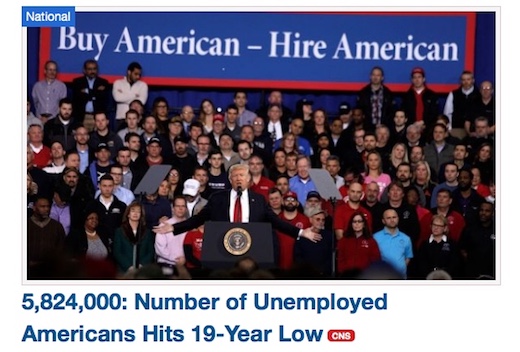Topic: CNSNews.com
 What CNSNews.com gave up in breadth of coverage of April's employment numbers -- only two articles this time around -- it more than made up for in gushiness. See how Susan Jones started her main story:
What CNSNews.com gave up in breadth of coverage of April's employment numbers -- only two articles this time around -- it more than made up for in gushiness. See how Susan Jones started her main story:
Not since 2000 has the number of unemployed Americans been this low.
That drop -- to 5,824,000 in April from 6,211,000 in March -- helped lower the nation's unemployment rate two-tenths of a point to 3.6 percent, the lowest rate since 1969.
The Bureau of Labor statistics counts people as unemployed if they do not have a job, have actively looked for work in the past four weeks, and are currently available for work.
Jones thenturned to the not-so-good news, which would have been the lead and headline of her article if Barack Obama was still president:
However, not everyone who is jobless is unemployed. A growing number, including retirees, are counted as not in the labor force, meaning they are not working and are not looking for a job. That number increased by 646,000 last month to 96,223,000.
The number of employed Americans, which has set 18 records so far in the Trump presidency, dropped slightly in April to 156,645,000 from 156,748,000 in March.
The economy added a strong 230,000 jobs last month, beating analysts' estimates of +190,000.
But the labor force participation rate dropped two tenths of a point to 62.8 percent, below the Trump-era high of 63.2 percent.
The only other story CNS did was its usual sidebar from Craig Bannister on Hispanic employment, which was similarly gushy. CNS editor in chief Terry Jeffrey did not contribute his normal sidebars on manufacturing jobs and government jobs.
This was, however, apparently replaced by another column by the Heritage Foundation's Timothy Doescher in full gush mode:
It’s time to celebrate: We have the lowest unemployment rate in 49 years, and wages continue to rise—especially for lower-wage workers.
On Friday, the Bureau of Labor statistics reported that in April, the economy created a whopping 263,000 jobs, and the U-3 unemployment rate—the one commonly cited—fell from 3.8 percent to 3.6 percent. The alternate measure for unemployment, the U-6, which includes those discouraged and underemployed as well, remained unchanged at 7.3 percent.
This is consistent with the larger pattern we’ve been seeing of the economy booming: Over the last year, our economy is averaging 213,000 jobs per month, and we now have 103 consecutive months of job creation.
Doescher waited until the 13th paragraph of his column to mention that it's "a little more troubling" that "the falling unemployment rate might be partially fueled by a decrease in the labor force participation rate."
Another column, by Hans Bader, was similarly gushy, proclaiming that "The Trump administration has helped fuel economic growth by bringing an end to the flood of red tape issued by the Obama administration." Bader identified no specific instance of red tape removal that could be tied to a specific impact on the economy.








